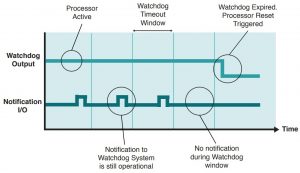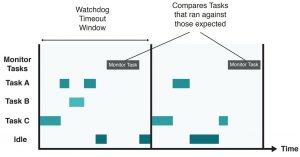Aerospace Engineer at WHIS
Last updated 30th October 2023
Basic Watchdog Protection
In a basic system, the designer may choose to have a periodic Task that simply notifies the Watchdog at the required frequency. In this scenario, the system remains available providing the Task that refreshes the Watchdog operates at the correct frequency. A complete systems crash or a failure within the Task notifying the Watchdog would cause the Watchdog to expire, placing the system into a safe state. However, if the system fails in a way whereby the Task that notifies the Watchdog remains operational but other mission critical Tasks fail to operate, the Watchdog would not place the system into a safe state.
Improving Robustness
An improvement to this simple system would be to notify the Watchdog that the system is OK only if all Tasks have been active during the last Watchdog refresh time-period. In this case Tasks would register with a Monitor Task so that each time a Task runs, it informs the Monitor Task. When triggered, the Monitor Task will check that all registered Tasks have operated during the last time-period; if they have, the Monitor Task will notify the Watchdog that the system remains operational.

Figure 1: Watchdog Timing Diagram
Task Monitoring By Watchdog
To manage Tasks operating at a higher or lower frequency than the Watchdog refresh rate, the designer would need to include a time profile for all Tasks. For each Watchdog refresh period, the Monitor Task would confirm that only the expected scheduled Tasks have been active. In some systems however, knowing the Task is still operational does not provide sufficient assurance that the system is still operating correctly. In these systems the operation of critical code sections must be monitored as well as the Tasks they are found within.
To complete the temporal monitoring of events, an additional enhancement would be to monitor the response time of Interrupt Service Routines (ISR). Here the Monitor Task would measure the actual time it takes to process the response, from the time the ISR is triggered to the time when the overall operation has completed.

Figure 2: Monitor Task Scheduling
By monitoring the timing profile of individual Tasks, critical code sections and ISR response times, the designer has a high level of assurance that the Watchdog notification mechanism is working as expected. However, the complexity of the Monitor Task has increased significantly.
Sophisticated Task Monitoring
SAFECheckpoints from WITTENSTEIN high integrity systems is a software component that provides this sophisticated Task monitoring capability, ensuring the scheduling of tasks is occurring as intended. The Checkpoints mechanism allows the user to specify timing tolerances for critical sections of code.
This can be used to ensure that:
- Periodic Tasks run within tolerances.
- Sections of processing within Tasks complete.
- ISR execution to Handler Task processing completes with allowable tolerances.
- Complex functionality involving multiple tasks completes within allowable tolerances
Individual Checkpoints can specify their own call-back function or the system error hook can be activated.
- Single shot and Periodic checkpoints can be created.
- Periodic checkpoints can operate in fixed or relative timing modes.
SAFECheckpoints is available with a full Design Assurance Pack supporting certification to IEC 61508 SIL 3, and is delivered fully integrated with either SAFERTOS® or SAFERTOS® CORE.
Related Topics
Further your knowledge of RTOS with our RTOS Resource Centre
Free Demos & Manuals
Download fully functional, time-limited SAFERTOS® demos, plus manuals, datasheets, and more.


